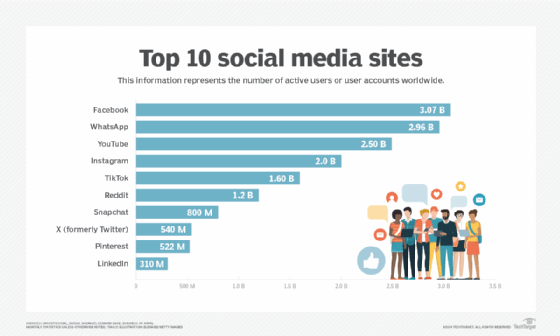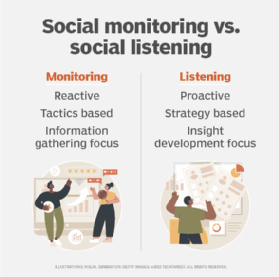
Getty Images
10 social media trends in 2024
Social media changes constantly. Using some of the latest trends -- such as social listening and short videos -- can help a company stand out.
People use social media daily, and businesses are flocking to it to reach customers.
To prevent information overload, businesses are getting creative with social media to reach customers. Organizations can use social media marketing to boost their business and reach different generations on the right platforms.
Globally, digital consumers use social media for an average of 2 hours and 23 minutes each day, according to research from GlobalWebIndex. There are plenty of new opportunities to use social media in different ways, including videos, customer service and social listening.
Staying on top of the latest social media and marketing trends can help businesses reach customers by standing out in a world of digital overload. Here are some of the top social media trends in 2024.
1. TikTok will continue to dominate
TikTok had more than 1.5 billion active monthly users in 2024 and is still growing, according to statistics from Statista.
For companies that want to reach younger audiences, TikTok is a must. It is one of the main platforms to reach Gen Z and millennial consumers.
Although short-form content was once king on TikTok, other formats -- such as long-form content and photos -- are becoming just as popular. TikTok has slowly rolled out more long-form options for videos up to 30 minutes.
TikTok has also become a key area for businesses to advertise -- especially to younger generations. The platform offers ads and business profile tools to expand its platform.
2. Video content stays king -- with a twist
Although video content remains dominant, short-form content isn't the only thing taking off. While short-form content is still the most popular way to attract and engage users, consumers also prefer a mixture of content types -- including both short- and long-form videos, text and images.
Businesses are also livestreaming to engage with consumers. These videos include telling a story, demonstrating a product, promoting events or sharing other company communications. Social media video length should be kept to around a minute, according to a Hootsuite blog post.

3. Social commerce will continue to expand
Buying products directly from social media has already become the norm -- and this trend continues to grow. Social networks are evolving into retail platforms with storefronts and shoppable posts. In fact, social commerce sales are predicted to reach $144.5 billion by 2027, compared to the $67 billion in sales in 2023.
Social platforms are integrating shopping and commerce into the experience. For example, TikTok Shop -- launched in 2023 -- sold $11.09 billion in gross merchandise value (GMV) and made up 68.1% of the total social shopping GMV in February 2024. Other social commerce platforms -- such as metaverse shopping -- are also evolving in the social and e-commerce world.
To create an ideal shopping experience, businesses should focus on simplifying clicks. They can do this by focusing on their most popular items instead of a full storefront.
4. Augmented reality will go mainstream
Other technologies -- such as virtual reality (VR) and augmented reality (AR) -- will become more mainstream and integrate with social media to offer more engagement with customers. While VR adoption is in the early stages, Instagram and Snapchat use AR to enhance the visuals shared on those platforms. For example, Snapchat has long used AR for its photo filters to turn people into animals, appear to have makeup, wear sunglasses or otherwise alter appearances.
Now more AR applications than just photo filters are available. Companies can use AR for product demonstrations, trying on virtual apparel and more. For example, consumers can see how furniture fits in a room or virtually try on sunglasses.
5. Influencer marketing continues to rise
Influencer marketing isn't new, but it isn't going away. In an age of social media gimmicks, authenticity is more important to consumers than ever, leading the way for the rise of influencer marketing -- especially with nano- and micro-influencers.
Investing in influencers may not be as expensive as other advertising or marketing campaigns, but it still delivers results. Eighty-five percent of marketers found influencer marketing to be effective, according to a report by Influencer Marketing Hub. And the industry is set to grow $2.4 billion by the end of 2024.
LinkedIn is another social media platform offering influencer marketing. While LinkedIn and influencer marketing are not commonly associated, LinkedIn offers Creator Accelerator -- an initiative to help creators build their communities -- showing they are looking to invest more in creators and influencers.
Using influencers can help companies do more than generate leads. Influencers can also help with customer engagement and promote customer loyalty.
Learn more about using influencer marketing to reach millennials and Gen Z.
6. Social media will be integral to effective customer service
Using social media as a customer service platform happened gradually as people realized they could reach out to companies directly. Customers ask questions or post complaints, and companies respond.
As important as customer service is, the key to customer satisfaction depends on response times. Seventy-six percent of consumers value fast response times from brands, and nearly 70% expect a response within 24 hours or less, according to Sprout Social.
To speed up response time, companies may want to invest in AI tools -- such as chatbots -- to handle some requests immediately or create a customer service knowledge base. In fact, there's been a 318% increase in how much organizations plan to use AI for customer support activities in 2024, according to Hootsuite.
7. More companies will use social listening
Businesses can gather insights and data from social media. By using social listening tools, businesses can observe the consumer world. The goal of social listening is to monitor conversations on social media and understand reactions.

Social listening enables companies to understand the impact of campaigns, brand perceptions and other insights on customer wants and needs. As brand playfulness continues to be important to consumers, staying on top of how consumers react to brands is important to ensure they react well to campaigns and brand messages.
To start, businesses can use branded hashtags, relevant keywords and company mentions in social campaigns to see the results.
Organizations can also use social media to help with crisis management communications. Consumers want businesses to be transparent and honest in a crisis, and 61% of users believe brands should acknowledge moments of crisis when they are happening, according to a Twitter survey.
Examples of social media crisis communications include those from grill manufacturer Weber. Right after Marvin Lee Aday's death -- aka singer Meat Loaf -- Weber sent out a recipe of the day for meatloaf. After social media backlash, Weber quickly emailed an apology, and customers shared it online.
8. SEO will become an important factor for growth
People no longer use social media just to share photos and memes. More and more people -- especially Gen Z -- are using social media such as TikTok and Reddit as search engines. In fact, 24% of consumers use social media to find answers to questions, according to Forbes.
Social media posts must incorporate SEO elements such as keywords, hashtags and alt text to help boost discoverability as they would on blogs and web pages.
Optimizing social media content and profiles can help attract target audiences and improve discoverability -- especially for informative content that consumers may search for.
9. Social audios will gain popularity
Even though audio is not new, its presence on social media is. Audio uses only the human voice to reach its audience, giving people the option to listen on the go.
Clubhouse -- a social audio app -- was popular in 2021, but the invite-only requirement made it difficult for all businesses to use, and it shut down in 2023. However, other platforms are now offering audio-only options. Facebook offers features such as Soundbites, podcasts and Messenger Rooms to support audio content. X -- formerly Twitter -- has an "X Spaces" feature for live audio-only conversations.
Trends for using social audio include live event broadcasting, voice messaging, music, live audio rooms and meetings.
10. AI will assist with content creation
2023 saw the rise of AI, and it continues to grow in 2024. Businesses can use AI content generation software -- such as ChatGPT, CopyAI and Jasper -- to draft social media posts. And recent advancements in AI have made it even more sophisticated, allowing companies to use AI for audio and video generation, too. Fifty-four percent of organizations plan to use AI for image creation in 2024, compared to 15% in 2023; and 86% plan to use it to edit and refine text, according to Hootsuite.
AI can assist with copywriting, but it cannot replace personalized and authoritative content from a human writer. AI can help draft content by outlining or reformatting existing content for other mediums, such as social media or email campaigns.
More businesses can use AI tools for recommendations on increasing user engagement to customize posts and captions to reach their target audiences.
Learn more about the pros and cons of AI-generated content.
Alison Roller is a freelance writer with experience in tech, HR and marketing.






